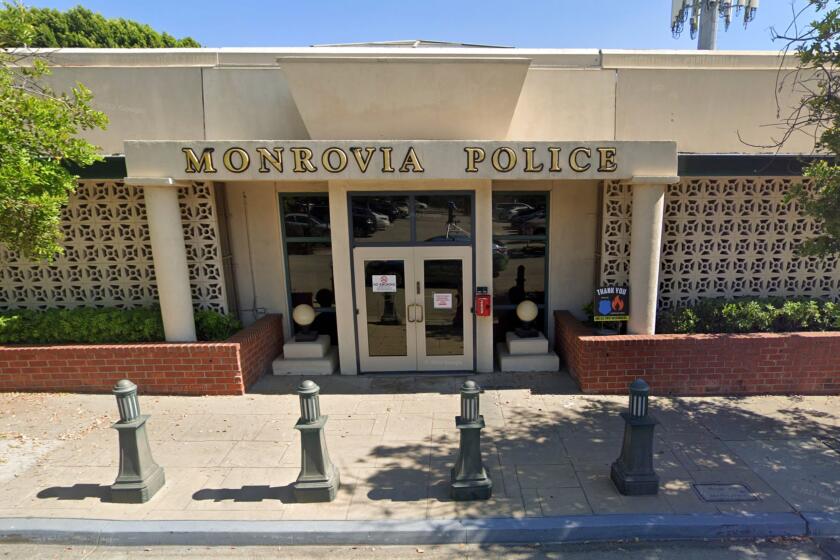With More Seniors, How to Pay for Meals?
Home-delivered meals are what keep people like 84-year-old Evelyn Osborne living in her Anaheim home and out of nursing facilities--saving taxpayers big money, social service experts say.
But the three nonprofit organizations that bring her and 4,000 other Orange County seniors their meals say they are running out of money to keep the food coming. They say they will have to cut the number of people they serve if the county does not step in to help.
The cuts would affect hundreds of Orange County senior citizens as soon as January 2002, a scary prospect for those trying to stay in their own homes.
“If I had to go out, I don’t know what I would do; I couldn’t make it,” said Osborne, who finds it difficult, even with a walker, to get across her Anaheim living room when the food arrives each day.
County officials say the nonprofit organizations--South County Senior Services, Feedback Foundation and Senior Meals and Services--have not provided enough data to support requests for $250,000 each, but they want to make sure the seniors get their meals. The county gives the Area Agency on Aging $358,000 a year, but that money pays for county administration of the senior citizen umbrella agency, not for senior meals.
The complaint that funding for programs has not kept pace with the growing senior population is not unique to Orange County. It’s one heard throughout the state.
“We are in a house of cards. There is not enough money from the county or the cities. We have been breaking our backs. The problem isn’t just ours. This is a problem of the aging of America,” said Marilyn Ditty, executive director of South County Senior Services.
Marilyn Fried, executive director of ONE--Organization for the Needs of the Elderly, which delivers meals to homes and at a center in the San Fernando Valley--agreed that “funding needs to be looked at with an eye on long-range planning. We can see the demand will skyrocket.”
This month, directors of the three Orange County programs will meet with county supervisors and other officials to discuss their funding crisis. Their concerns range from run-down trucks and offices to employee turnover and how to plan meals that in most cases must cost less than $1.30 each.
“We have played magic,” said Donna Biro, executive director of Senior Meals and Services in Garden Grove. “We have tried to keep the meals without looking at infrastructure. Something has to be done.”
The groups will meet with Supervisor Cynthia P. Coad, an advocate for seniors who sponsored a summit to gather seniors’ opinions.
Coad said she is willing to seek solutions to the problem, noting that the programs allow seniors to live independently at home. “It’s better for everyone if they get the meals,” she said.
The supervisor suggested that money could be saved by making the services more efficient. “I’m confident it can be worked out.”
Coad’s executive assistant, Bob Tunstell, said one approach might be to change the location of senior center meal sites and increase contributions from city budgets. “There is a shortfall, we know that. What we are trying to do is see if we can solve it,” he said.
Supervisor Tom Wilson said he is meeting with all three groups to better understand how they get money and how they spend it.
“We need to make sure all our seniors get good, nutritious meals,” Wilson said. “But we need to see how the money comes in, and until the clarifications are made, it’s hard to tell if the county should kick money in. It’s just too soon to tell.”
Those meetings will probably put more heat on Pamela Mokler, the new executive director of Orange County’s Area Agency on Aging.
Mokler’s job was vacant for 18 months and now that she’s arrived, senior service providers say they have high expectations.
“There are stakeholders on all sides,” Mokler said. “There are scarce resources. Whatever happens, we do not want seniors in their homes who need meals not to get them.”
Mokler said she is eager to continuing talking with the providers. A business plan scheduled to be released in June could propose county funding of meals programs. Mokler said she hopes the nonprofits will also consider alternative funding sources, such as Philip Morris Cos., which have a campaign to shorten meals-on-wheels waiting lists around the country.
But Mokler said the groups have not yet given her enough financial information to work with. The groups say the problem has been clear for years, but they are working to generate actual numbers for the officials.
Federal funding for the meal programs through the Older Americans Act has remained about the same since 1990, while costs and demand have sharply risen, the providers say. In 1993, the act provided $1.2 million for meals at senior centers and for home delivery in Orange County. The act provides 2% more in 2001, or $1.22 million. Other funding did not rise substantially, either.
While total funding has increased 25% between 1993 and 2000, the providers served 43% more meals, or 1.8 million in the 2000 fiscal year. At the Feedback Foundation, federal funding once paid $2.41 per meal but now pays $1.92.
Throughout California, county officials and nonprofit organizations say demand far exceeds local funding, as well as money that comes from the Older Americans Act. Even counties that have given substantial sums to senior services still face unmet demand.
Ann Smith, general manager of the Los Angeles city Department on Aging, said officials there began noticing the increasing senior population and for the first time helped fund meals directly, to the tune of $500,000. Smith said the demand continued and she overspent her budget by $300,000.
“What [the city] didn’t think of was that once we got rid of one waiting list, we’d get another,” Smith said.
Orange County has a high concentration of older residents because of the climate and coastal suburban environment. The number of people older than 60 in Orange County jumped 27% between 1990 and 2001, according to census statistics and estimates from Chapman University.
Forecasters say the same population will nearly double by 2020--from 391,000 now to 733,000. In Los Angeles County, seniors, now 13% of the population, are expected to be 20% in 29 years.
In Orange County, although there is considerable demand for meals delivered to seniors’ homes, providers keep a waiting list only of the most desperate cases: frail seniors with multiple ailments and no family or church to help them.
The waiting lists include as many as 65 people for each of the Orange County nonprofits on any given day; usually, the only way to be accepted into a program is if a current recipient dies or goes into a nursing home.
Most of the programs that offer home delivery or meals at senior centers don’t dare advertise their services.
“If we put a 3-by-4-inch ad in the paper, our phones would never stop ringing. We would only be creating false hope,” said Ret Wixted, executive director of the Feedback Foundation.
*
But finding the money to make the meals is only part of the problem. The groups also struggle to keep the people who deliver the meals. Employees leave for jobs with better benefits, and those who remain must wear several hats, the providers say.
One recent morning, Oggie Barney, 29, loaded up one of the foundation’s vans--in this case, a 1994 model with 120,000 miles on it--and set off on his rounds with meals of salami and cheese sandwiches for lunch and fish and potato nuggets for dinner.
His route takes him through modest neighborhoods in Anaheim, down streets where his clients once raised their children, worked in local factories and even picked the once-abundant oranges.
Barney wears baggy shorts and sports thick silver earrings in his chin, eyebrow and ears. He spends hours not only delivering meals but talking with the seniors. Even Evelyn Osborne, grappling with basic issues such as bathing and eating, asks about his dog.
“I went to Homegrocer.com to apply for a job,” Barney said. “They pay well--$14 an hour--but [there is] no contact with the customers. Here, we get close with our clients. We know their moods. You bond with them.”
His boss, Wixted, said only employees who feel like Barney stay. Others leave for bigger salaries and benefits. Barney, after seven years on the job, makes $10.35 an hour.
People like Clara Ingle, a 92-year-old Anaheim mother of two, wait for him every one of the five delivery days.
Barney “is the No. 3 son,” she said. “I’m alone. I don’t go anywhere. I don’t know what I’d do without him.”
More to Read
Start your day right
Sign up for Essential California for news, features and recommendations from the L.A. Times and beyond in your inbox six days a week.
You may occasionally receive promotional content from the Los Angeles Times.






